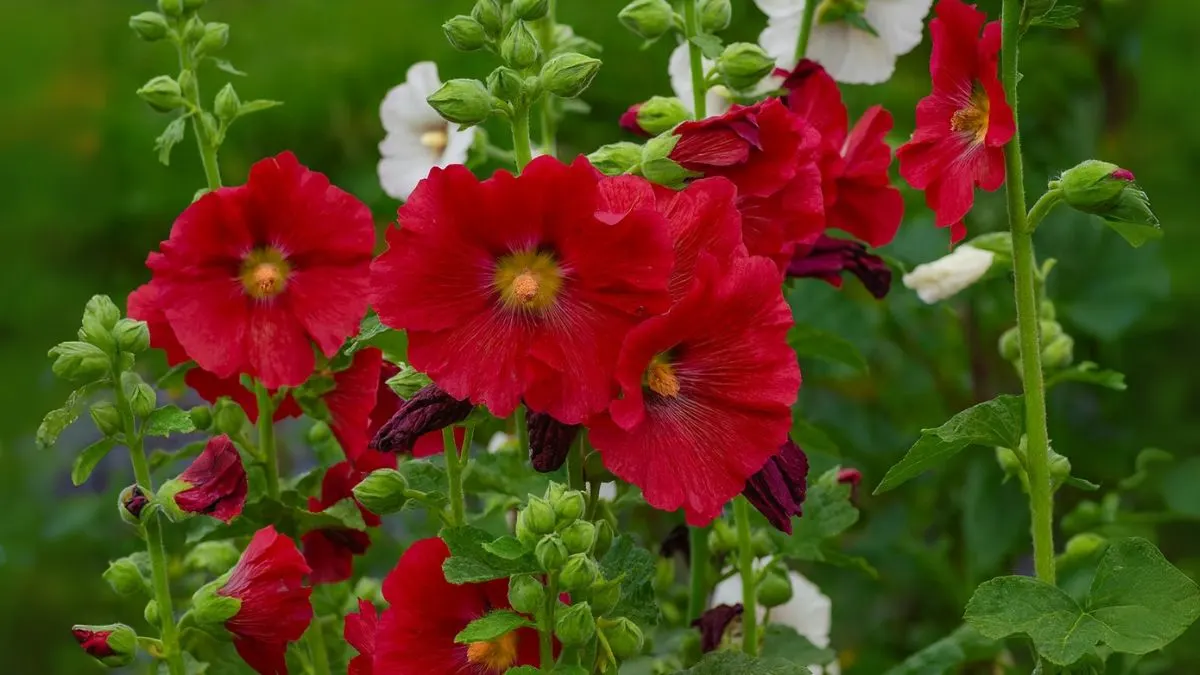Few flowers make as bold a statement in the garden as hollyhocks. With their tall, majestic stalks covered in blooms, they’re the kind of plant that instantly turns a garden bed into a cottage-style masterpiece. These flowers have been cherished for centuries across Europe and North America and are now popular worldwide for their beauty and easy growth.
If you’re wondering about growing hollyhock, this guide will take you through everything—from planting to care—so you can enjoy these blooms year after year.
Choosing the Right Spot for Hollyhocks

Hollyhocks are sun lovers. To get the best results, always plant seeds or young plants in full sun (6-8 hours daily) in well-drained, fertile soil amended with organic matter.
Key Lighting Needs:
- Hollyhocks can be started from seed indoors or out. But once planted outside, they’ll need strong sun to grow tall and healthy.
- Always plant them in beds that receive at least 6-8 hours each day for maximum bloom production.
Gardeners in Canada and the USA often grow hollyhocks along fences or the back of flower beds, where their height (sometimes 6–8 feet!) adds natural structure and color.
Soil and Watering Requirements
Hollyhocks are not very demanding, but the right soil makes a big difference. They grow best in a location with full sun and well-drained soil. Clay-heavy soils can suffocate the roots, so amend with compost or sand for better drainage.
Pro Tip: Always grow hollyhocks in moist but well-drained, light soil in a sunny spot. Too much standing water may cause root rot, while dry soil can stunt flower growth.
Also Read: Grow Clarkia and Watch Your Garden Explode With Color!
Planting Hollyhock Seeds or Young Plants
One of the best things about hollyhocks is how versatile they are when planting.
- From Seeds: Hollyhocks can be started from seed indoors or out. If starting indoors, sow them 6–8 weeks before the last frost, and transplant when seedlings are sturdy. Outdoors, sow seeds directly into the soil in spring or late summer.
- From Young Plants: Buy small hollyhock plants from a nursery and transplant them into sunny beds. Make sure they’re spaced at least 18 inches apart to give them room to breathe.
Growth Stages: What to Expect
Hollyhocks are biennials, which means they usually focus on leaf growth in the first year and flower in the second year. However, with proper care, some hybrids bloom in the first year itself.
Growth Stage |
What Happens |
Care Tips |
Year 1 |
Roots and leaves develop |
Keep soil moist and fertilize lightly |
Year 2 |
Tall stalks form with flower buds |
Stake plants to prevent leaning |
Blooming |
Vibrant flowers open |
Deadhead to encourage longer blooming |
Caring for Hollyhocks Throughout the Season
- Sunlight: They grow best in a location with full sun and well-drained soil, so avoid shaded corners of your yard.
- Fertilization: Add compost at planting and use a balanced fertilizer mid-season to keep plants strong.
- Pruning: Deadheading faded flowers encourages more blooms and prevents excessive self-seeding.
- Staking: Tall stalks can get heavy, especially in windy areas. Use stakes or grow them near walls/fences for support.
Also Read: Grow Cleome for Bold Blooms That Bees and Hummingbirds Can’t Resist
Common Challenges and Solutions
Like all plants, hollyhocks can face a few challenges.
- Rust Disease: A common fungal infection. Space plants properly and water at the base to prevent fungal spread.
- Pests: Aphids and caterpillars sometimes attack leaves. Neem oil sprays work well as a natural remedy.
- Overcrowding: Hollyhocks can reseed easily and overcrowd beds. Thin seedlings in spring to maintain airflow.
Why Hollyhocks Are Worth It
When I first planted hollyhocks in my garden, I underestimated their height. By mid-summer, their towering stalks created a wall of pink and yellow blooms that not only attracted bees but also became a conversation starter with neighbors. I had started them from seed indoors, and the satisfaction of watching them grow into full blooms was incredible.
Their ability to reseed also means they come back year after year, making them one of the most rewarding flowers for low-maintenance gardeners.
Hollyhocks are more than just flowers—they’re a piece of living architecture in your garden. If you want a garden that stops people in their tracks, add hollyhocks. They’re tall, colorful, and surprisingly easy to care for. Once you plant them, you’ll understand why these flowers have been beloved for centuries.






